It was Łańcut where we finally solved The Curious Incident of the Dog in the Light Grime.
We had intended to go to Kazimierz Dolny, dubbed ‘The Most Beautiful Town in Poland’, set amid a landscape of spectacular gorges and lakes. However, as we checked out of his campsite in Ojców, our host, Bartek, told us,
“Kazimierz Dolny is infested with mosquitos at this time of year. There’s a really lovely campsite at Łańcut, with lots of things to see close by.”
Recommendations rank highly in our route planning hierarchy, but Mosquito Avoidance trumps everything, so we set course for Łańcut, whose claim to fame is Poland’s largest palace. With three-hundred rooms, Łańcut Castle ranks as one of Poland’s National Historic Monuments.
Once again, the drive there was plain.
“You know that photo of a sea of barley that I took on our first leg between Bolków and Wrocław? I could use it for every journey we do across central Poland!” I said to Mark, although as we pushed east, the scene did change from bread basket to scrubby forest and poor agricultural land.
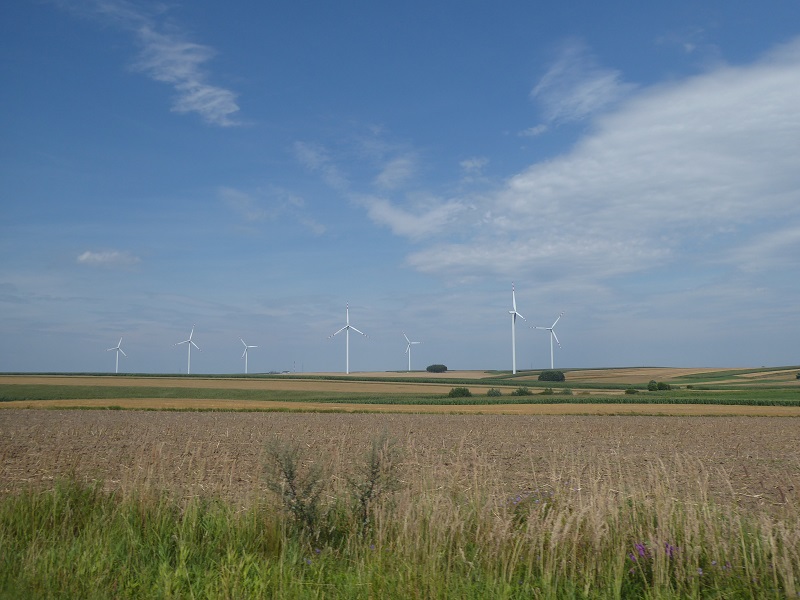
I still found items of interest to point out to Mark. “Look. There’s a field full of Przewalski’s horses! They’re really rare.”
Przewalskis are the horses you see in cave paintings. They are the equine equivalent of wolves or wildcats – the closest you can get to the original, pre-historic, non-domesticated animal. They are notable for their chestnut-dun colour, stocky build and erect mane. They have donkey-like features, such as a pale mealy muzzle and belly, and black stripes on their backs and the tops of their legs.

Przewalski’s horse courtesy of Markéta Machová on Pixabay 
Lascaux Stone Age Cave Painting Public Domain
As we passed road signs to Belarus, Slovakia, and Ukraine, Mark said, “We could clock up ten countries in this trip!”. For once, I urged caution,
“With the Coronavirus situation, I’m not sure we should go outside the E.U.. What if the borders close? They might not let us back in!”
A few days later, another reason not to stray too far came to light.
So often, ‘The Lamberts are coming!’ is the match to the blue touch paper of public unrest. It happened in Romania, Nepal and Zimbabwe – and less than a week after Mark and I had this conversation, Belarus confirmed President Lukashenko, ‘Europe’s Last Dictator’, for a sixth term. Anti-government protests started amid claims of widespread electoral fraud. Despite brutal suppression, the unrest escalated and continues. Although President L. is unpopular at home and abroad, he has powerful friends; notably one called Putin in the Kremlin.
The state of the world is casting a long shadow over our plans with The Beast, our new six-wheel expedition truck. Never mind Coronavirus, with conflicts breaking out in several countries on our proposed route to Mongolia, I bemoaned to Mark,
“The furthest we might end up taking The Beast could be Clacton!”
Not that we have anything against Essex – Mark’s Mum is an Essex girl. But it’s not Mongolia!

Camping Łańcut, was as lovely as Bartek promised. Mark, the owner and his wife had lived in Chicago for twenty years, but set up the site when they returned home to Poland. As a trucker, owner-Mark had roved all over the United States and Canada. We met his late-teenage daughter, Sarah, who was a sweetie. She had moved back to Poland aged eight and spoke English fluently, with a strong hint of stars and stripes.
I had a long conversation with Sarah, but first things first. I asked her,
“How do you say Łańcut?”
“Wine-Suit,” she said.
Well. If you can have a Smoking Jacket, why not a Wine Suit?!
When Sarah revealed that even she struggled to pronounce some Polish words, I felt vindicated. In return, I introduced Sarah to Welsh, one of Europe’s oldest languages. I still think Welsh is easier to articulate than Polish, despite all those Ls. All you have to remember is; F = V, Dd = Th, W = Oo and Ll = kind of Cl or Hl made with a hiss from both sides of the tongue to replicate the sound of a moderately outraged rattlesnake.
Sarah was suitably awed by my party trick, a recital of the second longest place name in the world; Llanfairpwllgwyngyllgogerychwyrndrobwllllantysiliogogogoch. Fifty-eight letters and the translation makes it sound more interesting than it is; ‘St Mary’s Church in the Hollow of the White Hazel Near to the Rapid Whirlpool of Llantysilio of the Red Cave‘. The reality is a mini-village, barely more than a train station, on the Isle of Anglesey.
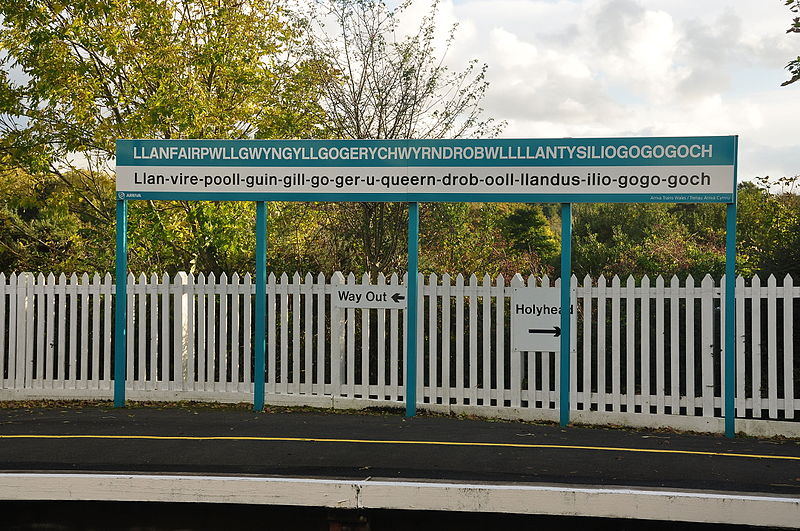
Credit: Nilfanion Wikimedia Commons Attribution-Share Alike 4.0 International license.
My careful research suggests the length of place names is inversely proportional to their significance. Capital cities rarely stray beyond three syllables. However, the longest place name in the world belongs to a small hill near Hawke’s Bay in New Zealand. This eighty-five-character classic is Taumatawhakatangihangakoauauotamateaturipukakapikimaungahoronukupokaiwhenuakitanatahu, named to commemorate an auspicious occasion; ‘The hilltop, where Tamatea with big knees, conqueror of mountains, eater of land, traveller over land and sea, played his koauau to his beloved.’
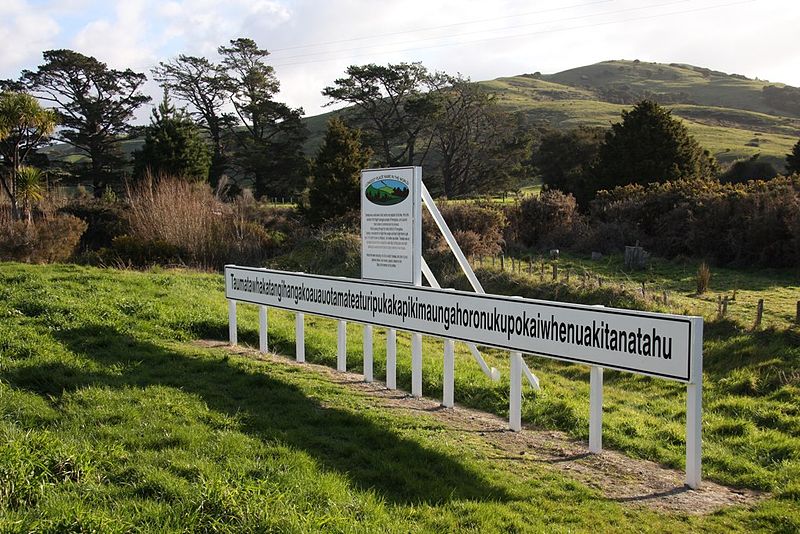
Credit: itravelNZ® Creative Commons Attribution 2.0
I can tell you two interesting things about Taumata, as it’s known for short. You can hear it spoken on the intro of ‘The Lone Ranger’ by Quantum Jump, since the band cunningly appropriated the hill’s Māori name as Tonto’s Native American chant.
The second interesting fact is that the name is actually an anagram of Whakatangihangakoauauotamateaturipukakapikimaungahoronukupokaiwhenuakitanatahutaumata.
Sarah told me she wanted to attend University in England or Scotland, although the Brexit spanner had clogged those undergraduate works.
“I’m sure the government will sort out some kind of study visa,” I said. “Overseas students are so important – they need someone to fill up and pay for all those University places!”
Sarah sent me away with a few Post-It notes listing Polish culinary specialities to try and the best restaurants in Łańcut to try them. Mark and I took an evening stroll into town along the road and through some waste ground. Presumably, we had deviated from the 1km route through the park that owner-Mark had suggested.
After some further navigational detective work (we still hadn’t mastered Google Maps) we found a restaurant that was both open and welcomed dogs. There, we sampled our first pierogi, the famous Polish dumplings filled with variations on the theme of meat, cabbage and cheese. We lingered over this very hearty plateful at a pavement café, which cost less than £20 for two, including a two-litre jug of beer. Our leisurely approach to dinner made our stroll back along the road and through the waste ground in the dark considerably less enjoyable!
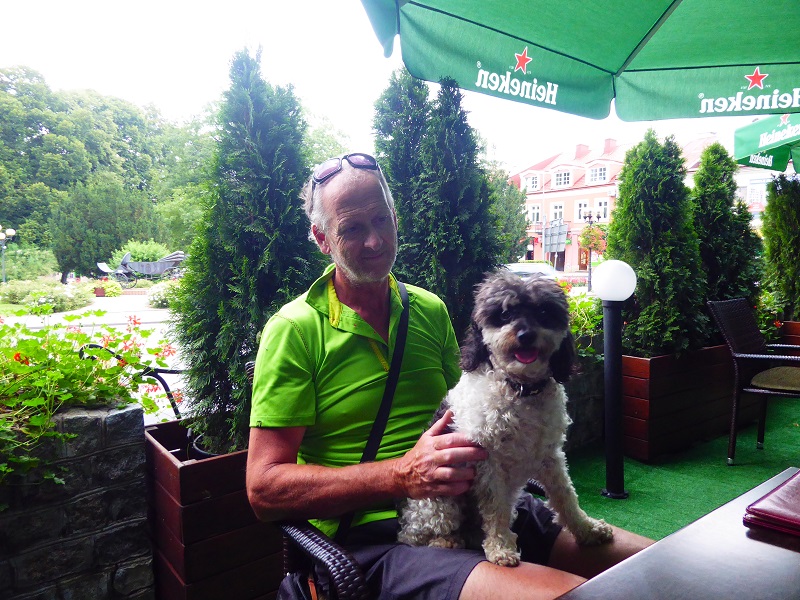
The following day didn’t start well.
Back in Ojców, I had confused our neighbours when I told them,
“I like Polish rain!”
I had to explain,
“Today’s forecast was for rain, but it’s forty-degrees and full sun!”
Yet the grey liquid version of Polish sunshine that blessed our morning was the least of our problems. When Mark returned from taking the dogs for their pee poo run, he announced,
“Rosie’s got worms!”
At last, an explanation for The Curious Incident of the Dog in the Light Grime. Over the past few days, Rosie had taken to rolling abundantly in all kinds of dust and dirt. It must have been because her poor little tum was so uncomfortable. Her worming treatment wasn’t due for a couple of weeks, so these were clearly nuclear-worms.
A quick internet search revealed the likely culprit. Way back in Alsace, we recalled Rosie treating herself to a crunchy snack as we walked through the vineyards – a long-dead mouse. A conversation with our vet back home confirmed our strong suspicion that the Ghost Mouse of Eguisheim was the most probable cause of Rosie’s vermicular infestation.
Thankfully, a single dose of Milbemax exorcised the ghost.
My own medical problems were less straightforward. I was rationing my meds for menopause and madness, since even pleas of lockdown hadn’t got me past the ferocious gatekeeping of my doctor’s receptionist. Issuing an international prescription was out of the question, she told me. Now, I had almost run out.
The Tourist Office in Kraków supplied details of the private company in Poland through whom I could see a doctor. Since phone-o-phobia is part of my madness, Mark rang the purportedly English-language help line. Communication was such a stressful experience that an hour later, Mark and I, the couple who don’t argue, were barely on speaking terms. At one point, a very frustrated Mark snapped out an order,
“Go and find Mark or Sarah!”
They could have acted as interpreters, but were nowhere to be found. The result was that my-Mark may or may not have made a doctor’s appointment at some building located somewhere within the Lublin city limits.
After an entire morning Living our Dreams via the medium of worming dogs, mis-communicating and being put eternally on hold in a rain-lashed caravan, Mark and I planned our afternoon. While places of interest looked nearby on the map, almost everything of note, other than Łańcut itself, was an hour-and-a-half’s drive away.
Thankfully, our mood brightened with the day as the liquid sunshine made way for another scorchingly blue sky. We drove into Łańcut to avoid the roads and wasteland, parked at the castle gates and bought an enormous compensatory ice cream.

Since we travel with four dogs, we had never expected to go inside the castle. In the grounds, a man taking photographs lamented,
“I can’t go inside. Entry slots are limited because of Covid. You have to buy a ticket and they’re all sold out.”
We had passed through five countries and noted wildly varying responses to the Coronavirus pandemic. Italy and Germany were strict – everyone wore face masks. In Germany, a café even took our address and phone number for contact tracing when we stopped for a quick coffee on a table outside.
France was more laissez-faire, with face coverings up to the conscience of the individual. In Poland face masks were universal in public places, although notably, during our two stops in the Czech Republic, the only mask I saw was my own. It did not surprise me when, a few months later, Czechia declared a national Covid emergency.
In the U.K., the Eat out to Help Out scheme was launching to boost business. Taxpayers would subsidise half-price meals – up to £10 per person – between Mondays and Wednesdays throughout August. Mark and I felt no gratification in our entirely predictable prediction about the rise in U.K. case numbers come September.
Back in Łańcut, we finished our ice creams and wandered around the outside of the palace. Our friend Kazimierz the Great, son of The Elbow High, founded the town in the mid-1300s on an important trade route linking Western Europe with Ukraine, Hungary and Poland. The palace dates to 1642, although it was reconstructed and modernised over many years. By the 1800s, its rambling Baroque elegance made it one of the finest residences in Europe, which hosted many exalted guests, including Louis XIII of France and Emperor Franz Josef of Austria.
Later, we found the dogs should have been on leads in the extensive English-style parkland gardens, although nobody seemed to worry. They ran happily on the vast fields of grass, shaded by magnificent mature trees. The buildings in the grounds, such as the Orchid House and the former stables and coach house, with its collection of eighty historic horse-drawn carriages, were closed.

Sometimes, the castle is known as the Potocki Palace, after its final owners. One of Poland’s most powerful families, the Potockis were connected through marriage to most of Europe’s aristocracy, including the Habsburgs. Just before the Soviet army entered Poland and the outcome of WWII became clear, the last Lord of Łańcut, Alfred III Potocki, fled and abandoned his palace forever.

I found a previous owner, Stanisław Stadnicki, even more fascinating. Locals knew him as Diabeł Łańcucki – the Devil of Łańcut, for his ‘colourful’ behaviour.
Stadnicki might have inspired the 16th-century version of Nightmare Neighbours. He robbed townspeople and, with his two-thousand-strong army of mercenaries, waged private wars on adjoining estates.
Tired of his exploits, Łukasz Opaliński, Governor of Leżajsk and Duchess Anna Ostrogska set up an extreme Neighbourhood Watch scheme to sort him out. They merged their armies, set fire to his castle, then beheaded Stadnicki. On dark nights, legends say you can see his ghost riding a black horse.
Opaliński claimed to have ‘Defeated the Devil and burned down Hell in Łańcut’, but diabolical family habits die hard. Stadnicki’s wife Anna became known as the ‘Łańcut Devil-Woman’, while his sons’ behaviour earned them the title of the ‘ Łańcut Devil-Children’.
Never mind the darkness, the road and the wasteland, we now had an additional ghostly reason to drive into town for dinner. Since we knew where it was, we returned to Restaurant Antico. Mark sampled pancakes, and I pointed at gyros on the menu and asked the waitress, “What’s that?”
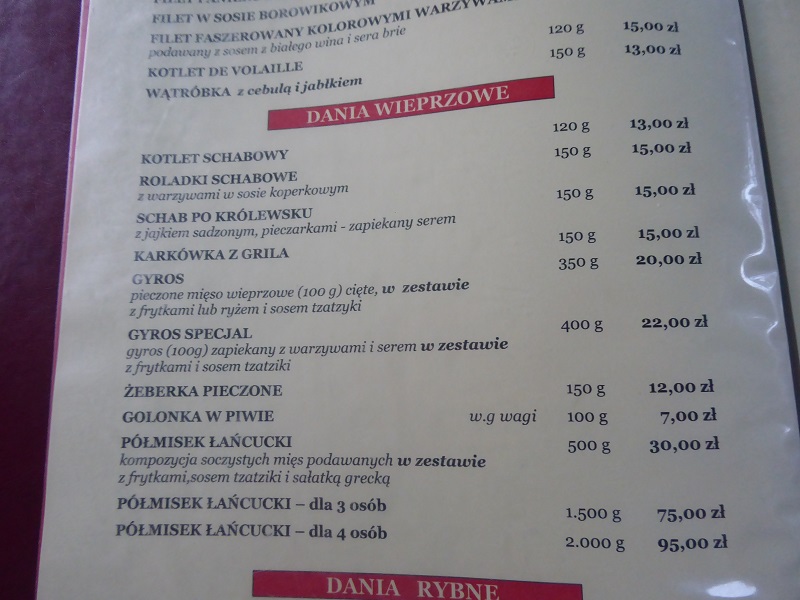
I never got an answer, but I did get a cheese-topped pork chop, with onions and peppers on the side. I suppose that constitutes veggies in Poland!
We decided to move on the next morning, although like the Devil of Łańcut’s last stand, we returned from dinner to find Caravan Kismet hemmed in by an army of neighbours in tents and motorhomes.
“That should make getting out tomorrow interesting!” Mark said.
Quite how interesting, we could never have guessed!
Join us next time to see how Our Escape from Łańcut goes!




Fascinating as always, and I recently tried Pierogi for the first time too, so tasty.
LikeLiked by 1 person
Pierogi are fab, aren’t they?
Glad you enjoyed the post!
LikeLike
Yes to both!
LikeLiked by 1 person
I’m really glad we don’t stay in one of those two town with the 50-odd letters of alphabet … imagine how you must try and explain this to people when they ask where you live 😳.
Although, the castle had “colourful” owners, their garden is really beautiful!
Thanks, I’ve enjoyed your post and can’t wait for the next episode …
LikeLiked by 1 person
Thank you – I am pleased you enjoyed the post!
The village in Wales is more practically known as Llanfairpwll or Llanfair P.G.
You would probably still have to explain that!
I’m from Blackburn and live in Bournemouth. Two syllables. Simples!
LikeLike
I’d love a wine suit! Love the easy to remember translation:) Maggie
LikeLiked by 2 people
🙂
LikeLiked by 1 person
Love “Wine-Suite” 😂 It is pretty close to the correct pronunciation and also sounds funny! 👏👏👏👍
LikeLiked by 2 people
Thank you! Glad I got close! 🙂
LikeLiked by 1 person